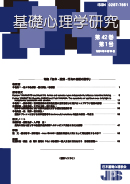Current issue
Displaying 1-29 of 29 articles from this issue
- |<
- <
- 1
- >
- >|
Special Edition: Psychonomic research of body and action
Preface
-
2023 Volume 42 Issue 1 Pages 1-2
Published: September 30, 2023
Released on J-STAGE: February 07, 2024
Download PDF (135K)
Original Articles
-
2023 Volume 42 Issue 1 Pages 3-10
Published: September 30, 2023
Released on J-STAGE: February 07, 2024
Advance online publication: November 28, 2023Download PDF (443K) -
2023 Volume 42 Issue 1 Pages 11-18
Published: September 30, 2023
Released on J-STAGE: February 07, 2024
Advance online publication: November 28, 2023Download PDF (299K) -
2023 Volume 42 Issue 1 Pages 19-25
Published: September 30, 2023
Released on J-STAGE: February 07, 2024
Advance online publication: November 28, 2023Download PDF (459K) -
2023 Volume 42 Issue 1 Pages 26-37
Published: September 30, 2023
Released on J-STAGE: February 07, 2024
Advance online publication: November 28, 2023Download PDF (867K) -
2023 Volume 42 Issue 1 Pages 38-46
Published: September 30, 2023
Released on J-STAGE: February 07, 2024
Advance online publication: December 06, 2023Download PDF (649K)
Research Note
-
2023 Volume 42 Issue 1 Pages 47-52
Published: September 30, 2023
Released on J-STAGE: February 07, 2024
Advance online publication: November 28, 2023Download PDF (503K)
Review
-
2023 Volume 42 Issue 1 Pages 53-64
Published: September 30, 2023
Released on J-STAGE: February 07, 2024
Advance online publication: December 12, 2023Download PDF (790K)
Book Review
-
2023 Volume 42 Issue 1 Pages 65-66
Published: September 30, 2023
Released on J-STAGE: February 07, 2024
Download PDF (207K)
Lectures The 41st Annual Meeting
Symposium 1: Adaptive information processing in the natural environment with regularity and redundancy
-
2023 Volume 42 Issue 1 Pages 67-68
Published: September 30, 2023
Released on J-STAGE: February 07, 2024
Download PDF (119K) -
2023 Volume 42 Issue 1 Pages 69-73
Published: September 30, 2023
Released on J-STAGE: February 07, 2024
Download PDF (333K) -
2023 Volume 42 Issue 1 Pages 74-79
Published: September 30, 2023
Released on J-STAGE: February 07, 2024
Download PDF (672K) -
2023 Volume 42 Issue 1 Pages 80-88
Published: September 30, 2023
Released on J-STAGE: February 07, 2024
Download PDF (636K) -
2023 Volume 42 Issue 1 Pages 89-94
Published: September 30, 2023
Released on J-STAGE: February 07, 2024
Download PDF (408K)
Symposium 2: Overcoming pitfalls in animal cognition research
-
2023 Volume 42 Issue 1 Pages 95
Published: September 30, 2023
Released on J-STAGE: February 07, 2024
Download PDF (117K) -
2023 Volume 42 Issue 1 Pages 96-102
Published: September 30, 2023
Released on J-STAGE: February 07, 2024
Download PDF (310K) -
2023 Volume 42 Issue 1 Pages 103-107
Published: September 30, 2023
Released on J-STAGE: February 07, 2024
Download PDF (248K) -
2023 Volume 42 Issue 1 Pages 108-114
Published: September 30, 2023
Released on J-STAGE: February 07, 2024
Download PDF (397K) -
2023 Volume 42 Issue 1 Pages 115-120
Published: September 30, 2023
Released on J-STAGE: February 07, 2024
Download PDF (337K)
Symposium 3: Psychonomic studies on human error
-
2023 Volume 42 Issue 1 Pages 121
Published: September 30, 2023
Released on J-STAGE: February 07, 2024
Download PDF (109K) -
2023 Volume 42 Issue 1 Pages 122-127
Published: September 30, 2023
Released on J-STAGE: February 07, 2024
Download PDF (284K) -
2023 Volume 42 Issue 1 Pages 128-133
Published: September 30, 2023
Released on J-STAGE: February 07, 2024
Download PDF (254K) -
2023 Volume 42 Issue 1 Pages 134-139
Published: September 30, 2023
Released on J-STAGE: February 07, 2024
Download PDF (538K)
Forum: Considering the environment of face recognition: Relationship between masked faces and visual deprivation
-
2023 Volume 42 Issue 1 Pages 140-141
Published: September 30, 2023
Released on J-STAGE: February 07, 2024
Download PDF (125K) -
2023 Volume 42 Issue 1 Pages 142-148
Published: September 30, 2023
Released on J-STAGE: February 07, 2024
Download PDF (499K) -
2023 Volume 42 Issue 1 Pages 149-154
Published: September 30, 2023
Released on J-STAGE: February 07, 2024
Download PDF (278K) -
2023 Volume 42 Issue 1 Pages 155-158
Published: September 30, 2023
Released on J-STAGE: February 07, 2024
Download PDF (201K)
Tutorial
-
2023 Volume 42 Issue 1 Pages 159-167
Published: September 30, 2023
Released on J-STAGE: February 07, 2024
Download PDF (466K)
Trend
-
2023 Volume 42 Issue 1 Pages 168-170
Published: September 30, 2023
Released on J-STAGE: February 07, 2024
Download PDF (250K)
- |<
- <
- 1
- >
- >|
